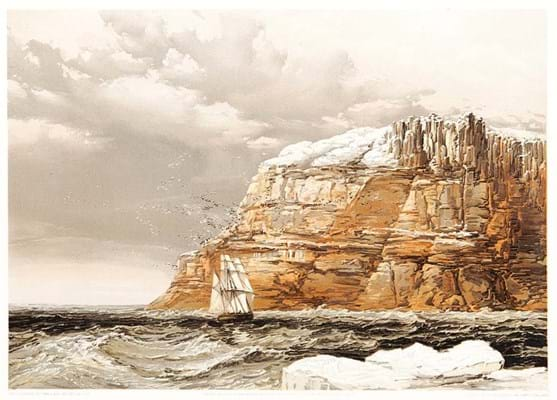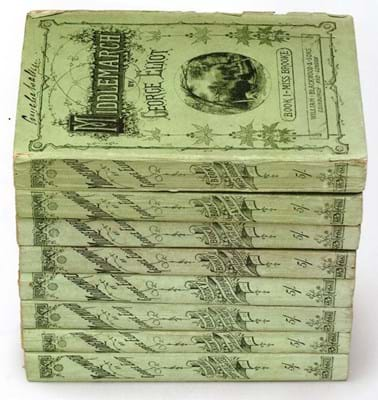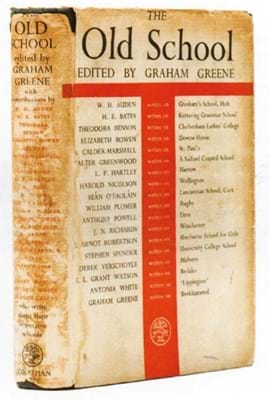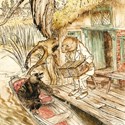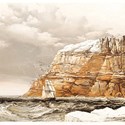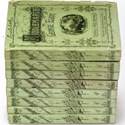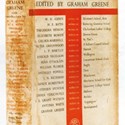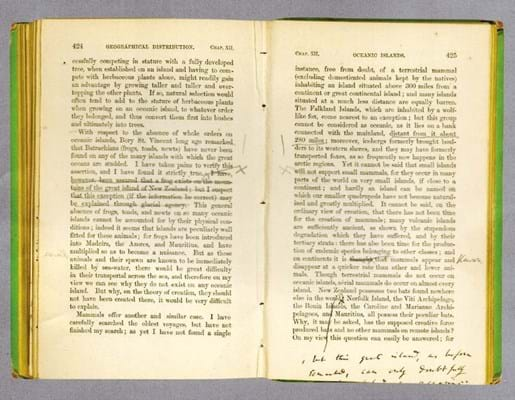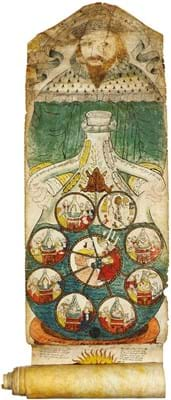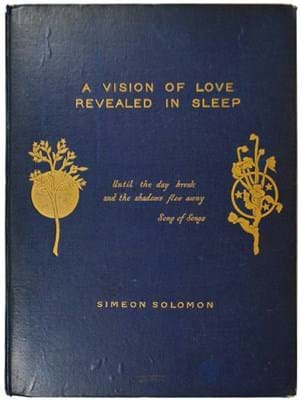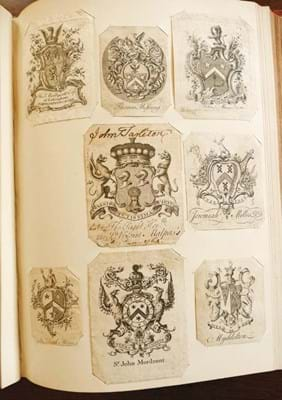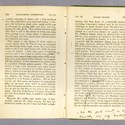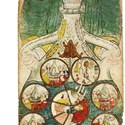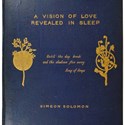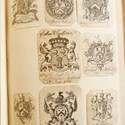Just as in 2016, the last two months of 2017 were packed with book, manuscript and related auctions in the UK, Europe and in the US.
In fact, this end-of-year gathering of sales, big and small, seemed even busier and the coming weeks will feature a series of reports ranging over many fields of collecting interest.
Offered here is just a small sample of what was on sale, including some of the spectacular, six-figure lots and a few much more modestly priced but very interesting or unusual items.
Rackham down to last detail
Fifty Rackham lots sent to auction by family descendants formed part of the book illustration section of a Sotheby’s (25/20/12.5% buyer’s premium) sale of December 11-12.
Sold at £42,000 was the final illustration (above) for the 1940, Limited Editions Club version of Wind in the Willows, as noted by Rackham’s daughter, Barbara, on the back of the board.
Rackham had died in 1939 and in his 1960 biography, Derek Hudson wrote: “The last drawing of all to be finished was that of Rat and Mole loading their boat…
“Rackham’s daughter remembers his great exhaustion and the extreme difficulty he had in getting it done. When he had, as he thought, he suddenly discovered there were no oars in the boat.
“Barbara tried to persuade him that this was a detail that did not matter, but he insisted that everything must be right, and with great labour he altered the drawing and put in the oars. After he had done this, he lay back in bed and said: ‘Thank goodness, that is the last one.’ And so it proved in every sense.”
Another fine Cresswell view
Highlights from the Martin Greene Library, a 421-lot Christie’s New York (25/20/12.5% buyer’s premium) sale of December 7 focused on ‘Russian America and Polar Exploration’.
A good many of the more successful lots were indeed Russian publications, but here we feature an English work that set a record.
Samuel Gurney Cresswell’s Series of Eight Sketches in Colour of the Voyage of the Investigator (Captain M’Clure) during the Discovery of the North-West Passage of 1854 deals with a Franklin search expedition of 1851 that two years later left the ship trapped in the ice and abandoned to its fate.
On the rare occasions that this work comes to auction, it is a fine plate showing that incident which is always highlighted, but this recent outing also offered the chance to reproduce another of Cresswell’s fine views. Shown below is ‘Bold Headland on Baring Island’.
In rebacked and repaired but contemporary boards with a gilt morocco lettering piece to the upper cover, and bearing a presentation inscription from Cresswell to a Thomas Masters Grendon(?), it sold for £60,000.
Seven years ago the wreck of the Investigator was finally found, at a depth of eight metres and just off Banks Island in the Beaufort Sea.
'Greatest novel' in eight parts
Sold for a record $65,000 (£48,510) by Christie’s New York (25/20/12.5% buyer’s premium) on December 5 was a fine and bright set of George Eliot’s Middlemarch in the original eight parts of 1871-72.
The issue of 5/- parts every two months was the suggestion of Eliot and her partner, George Lewes. However, although readers got more to read in each part than was usual for such serial issues, the higher cost and longer wait between parts meant that Eliot had to work hard to keep readers interested during the longer waiting periods.
In the end, a novel that Virginia Woolf saw as “magnificent” and one that in more recent times both Martin Amis and Julian Barnes have called “the greatest of English novels” sold some 5000 copies in this form.
Old-school Graham Greene
Two or three other copies appear in auction records of past decades, but for the “scarce piece of Greeniana” shown above, a 1934 work called The Old School, the previous best was $90 in a Swann Galleries sale of 1982.
Edited by Greene and containing contributions by WH Auden, HE Bates, LP Hartley, Anthony Powell and many more besides, this copy in a rubbed, torn, browned and spotted jacket made a far more substantial £1700 in a Forum Auctions (25/20/12% buyer’s premium) sale of December 6.
Original Darwin revisions reveal definitive Species
Sold for £650,000 at Christie’s (25/20/12.5% buyer’s premium) on December 13 was a “long-lost” 1861 edition of On the origin of Species… whose pages Darwin used to make autograph revisions to be sent to his German translator, HG Bronn, and incorporated into a planned second German edition.
The majority of those revisions were then incorporated into the fourth English and all subsequent editions to create what is regarded as the definitive text. The rediscovery of this annotated copy allows for the first time a precise reading of Darwin’s exact revisions, “without the veil of reconstruction and translation”.
Individual leaves of autograph drafts relating to his ‘big book’ appear occasionally on the market but, said Christie’s, no other example of Darwin’s revisions to the printed text are known to have been offered.
The volume was accompanied by an 1879 letter from Darwin to Melchior Neumayr, a German palaeontologist who had acquired this marked-up version following Bronn’s death in 1862. Descendants of Neumayr sent the work to auction this year.
As the illustration above shows at lower right, some notes were shaved when Darwin’s annotated texts were rebound in green cloth.
Quest for Philosopher's Stone
The ‘Ripley Scroll’, an early 17th century illustrated alchemical manuscript in English and Latin, sold for £480,000 at Christie’s (25/20/12.5% buyer’s premium) on December 13.
A mix of cryptic verse, legend and pictures, it is the only one of 23 known copies still in private hands.
A complex emblematic representation of the prime alchemical quest — the creation of a Philosopher’s Stone, the means of converting base material into gold – its composition is attributed to the foremost English alchemist, George Ripley (d.1490), an Augustinian canon at Bridlington in Yorkshire and author of The Compound of Alchemy.
In the opening section, reproduced right, a large figure holds the Hermetic vessel or ‘Philosopher’s Egg’.
This is a glass flask, within which are eight linked roundels, seven of them containing figures, apparently female as well as male, watching flasks or retorts (over a furnace) that in turn contain small naked figures.
In the neck of the main flask there is a spread-eagled toad surrounded by drops of blood.
There is a colophon after the final text section of the 12ft (3.7m) long scroll which reads “Leonard Smethley fecit 1624”. An arms painter and deputy herald of that name is documented as resident and active in Manchester at that time.
A copy of the Ripley Scroll in the British Library collections is currently a centrepiece in its exhibition Harry Potter: A History of Magic, which runs until February 28.
Solomon's pioneering vision
A Vision of Love Revealed in Sleep, an 1871 prose-poem by the Pre-Raphaelite and Symbolist painter, Simeon Solomon, is regarded as a pioneering work in the history of gay literature.
However, two years after A Vision… was published, many of the painter’s friends and admirers distanced themselves following his arrest for indecent behaviour in a public lavatory, an incident that proved ruinous to his career and led in time to an alcoholic decline and the workhouse.
In a December 8 sale held by Lawrences (19.5% buyer’s premium) a copy (above) that showed some spotting and browning, was cracked at the hinges and slightly shaken in its bumped and rubbed binding, nevertheless raised a bid of £3000.
In 2015 a copy Solomon inscribed “…with affectionate regards to his friend A.C. Swinburne” made a record $14,000 (then £8535) at Bonhams New York, but no other has bettered the price achieved in the recent Crewkerne sale.
Bookplates impress
Bid to £3400 in the book section of the December 9 sale held by Lacy Scott & Knight (20% buyer’s premium) was a collection of over a thousand bookplates, seemingly compiled around the end of the 19th century and in large part contained in two albums.
Most are armorial and associated with English nobility, but bookplates used by Dickens and David Garrick were also present in the collection.



